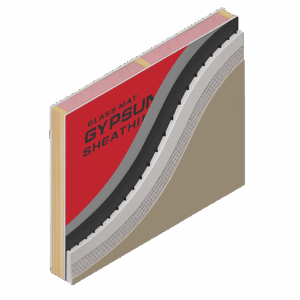In today’s built environment, performance expectations for wall, roof/ceiling and floor/ceiling assemblies are higher than ever. Architects, engineers, and contractors are tasked with delivering buildings that are not only aesthetically pleasing and structurally sound but also resilient and capable of meeting fire, moisture, and acoustic challenges. Gypsum panels, when properly selected and installed, offer a robust solution that meets these demands across project types.
Fire Resistance: A Critical First Line of Defense
Fire safety is a fundamental consideration in any building. The passive fire resistance afforded by gypsum panels is why these products are essential components of code-compliant building systems. Type X gypsum panels, for example, play a key role in tested and approved rated fire-resistive assemblies helping to compartmentalize fire, protect structural integrity and meet building code requirements. Type X gypsum panels are specially formulated in such a way to reinforce the core and help it remain intact at high temperatures, delaying the spread of flames and heat.
Resources like the GA-600 Fire Resistance and Sound Control Design Manual help guide professionals in selecting the correct wall, ceiling, or shaftwall assembly. But performance doesn’t end at panel selection. Fasteners, framing and proper installation practices are equally vital to preserving the rating.
Pro tip: Always verify that the selected assembly has been tested as a complete system and matches field conditions, including wall height, stud spacing, and penetrations.
Moisture Resistance: Navigating the Building Envelope
Gypsum panels designed for moisture-prone areas have come a long way. Glass mat gypsum panels, for example, are increasingly used as exterior sheathing in areas with intermittent exposure to water or humidity.
These panels offer mold and moisture resistance without sacrificing ease of installation. In building envelopes, they pair effectively with air- and water-resistive barriers to create tight, code-compliant exterior walls that perform well in all climates.
Best practice: Use ASTM C1177-compliant panels for exterior sheathing and consider specifying mold-resistant interior products in areas like bathrooms, kitchens and utility rooms.
Acoustic Performance: Meeting Privacy and Comfort Demands
From health care and education to multifamily housing, acoustic design is essential for occupant comfort and privacy. Gypsum assemblies can be configured to deliver high Sound Transmission Class (STC) ratings, especially when combined with insulation, resilient channels or multiple layers.
Using tested systems makes it easier to hit STC targets, often 50 or higher, with affordable and lightweight solutions.
Pro tip: Look for assemblies tested under ASTM E90 and E413, and avoid compromising acoustic performance during construction by sealing gaps and properly aligning framing during construction.
A System-Based Approach
What makes gypsum panels truly valuable is how they work as part of a larger system. Whether you’re building a fire-resistive hallway, a moisture-resistant exterior wall or a quiet partition between apartments, gypsum panels are essential to achieving performance goals.
For the A/E/C community, staying informed on new product innovations, installation guidelines, and evolving building codes is key. Organizations like the Gypsum Association, ASTM International, and UL can help professionals stay up to date and ensure their designs are resilient, code-compliant, and built to last.
